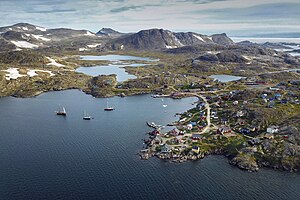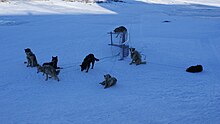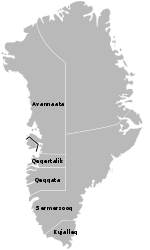| Kulusuk Kap Dan | |
|---|---|
 Kulusuk Kulusuk | |
 | |
| Coordinates: 65°34′31″N 37°11′00″W / 65.57528°N 37.18333°W / 65.57528; -37.18333 | |
| State | |
| Constituent country | |
| Municipality | |
| Founded | 1909 |
| Government | |
| • Mayor | Pele Maratse |
| Population | |
| • Total | 241 |
| Time zone | UTC−02:00 (Western Greenland Time) |
| • Summer (DST) | UTC−01:00 (Western Greenland Summer Time) |
| Postal code | 3915 |
Kulusuk (old spelling: Qulusuk), formerly Kap Dan, is a settlement in the Sermersooq municipality in southeastern Greenland, located on an island of the same name. The settlement population of 241 includes many Danes choosing to live there due to the airport. In the Kalaallisut language, the name of the village means "Chest of a Black Guillemot".
Geography
The urbanized area of the settlement is centered around the harbour in the northwestern part of the island, on the shores of the Torsuut Tunoq sound. Industrial utility buildings are also scattered in the vicinity of the airport, to the northwest of the runway.
Kulusuk Island
Main article: Kulusuk IslandThe island measures 8 km (5.0 mi) from north to south and 11 km (6.8 mi) from west to east. It is hilly throughout, with several distinct mountains dominating the eastern and southern coast. The southernmost point is Cape Naujaangivit, formerly Cape Dan (Danish: Kap Dan, a name previously extended to the settlement and island) under the Isikajia mountain.
Qalorujoorneq
Main article: QalorujoorneqThe highest point on the island is the summit of Qalorujoorneq, at 676 m (2,217.8 ft) topping a wide mountain massif in the southeast, directly above the airport.
History
From prehistory until 15th century

The Saqqaq people were the first to reach eastern Greenland, arriving from the north through what is now known as Peary Land and Independence Fjord. They were displaced by the Dorset culture around 3,000 years ago. The Thule people passed through the area in the 15th century, finding the southeastern coast uninhabited.
18th and 19th centuries
Due to back-migrations to the more densely populated western coast, the southeastern coast was deserted for another two hundred years. The region was not settled until the late 18th century, with the current town of Tasiilaq – then known as Ammassalik – surviving as the only permanent settlement in the 19th century. Population increased however from the 1880s, dispersing over several villages in the area.
20th century

The small Kulusuk Island was not permanently settled until the early 1900s, with the village founded only in 1909, celebrating its 100th anniversary in 2009. The church in the village was constructed in 1908 by the crew of a Danish sailing vessel that ran aground on the nearby coast and constructed from the timbers of the ship itself. A model of the ship still hangs above the organ of the church, rebuilt and brought into its present state in 1922.

The village cemetery is located about 200 m (656.2 ft) southeast of the village center, on permafrost ground, straddling the southern and northern slopes of a small hill. No names appear on the crosses in honour of the Inuit tradition that the name of the deceased is passed on to another at death and lives on to the next generation.

In the 1930s the population reached 165 inhabitants, the village surpassing the older Tasiilaq as the largest settlement in the region. As of 2013, Kulusuk is the third-largest settlement in the region, after Tasiilaq and Kuummiit, and the fourth-largest on the eastern coast, although the number of villagers dipped below 300 in the late 2000s.
Language
Main article: Tunumiit languageDue to its relative and longstanding isolation, the dialect of Greenlandic spoken in Kulusuk, Tunumiit oraasiat, differs from that of its relatives of the western coast. Amongst Greenlandic dialects, it is considered the most innovative.
Facilities

Medical services are provided by one resident Danish nurse and one resident educated local helper. The school, which was rebuilt in 2005, has about 70 pupils with a high proportion of educated teachers. In 2009 the village received permission from the Sermersooq municipal authorities to convert the old Royal Greenland fish processing plant for school use.
Few families have access to running water. Despite the harsh, icy winter, potable water drawn from the centrally located lake is available all year round through the central pump installation. As in most settlements in Greenland, pipe waterworks are led above the ground due to permafrost.
The village is served by the communal all-purpose Pilersuisoq store with an integrated a post office of Post Greenland.
The village has a small Lutheran church, which includes elegant stained glass windows donated by a German glassworks owner.

Tourism

Unemployment is high and many of the villagers depend upon tourism to supplement the more traditional pursuits of hunting and fishing. The village is served by Hotel Kulusuk which was erected in 1999 and provides a base for tourists and hikers. Day trips organized by the hotel and Icelandair focus on the traditional culture of eastern Greenland, including drum dance performances and dogsledding.
In summer, activities as glacier walks, ice climbing and visiting ice caves can be done with the help of local adventure companies.
In winter it is possible to cross the frozen sounds, making Kulusuk no less attractive for mountaineers, climbers, and polar adventurers than the neighboring Tasiilaq. The mountains on Apusiaajik Island dominating the Kulusuk panorama culminate in several summits, whilst the front of the active Apusiaajik glacier can be reached on foot or by snowmobile.
Polar cruises bound for, or returning from the coastal voyages in the Kangertittivaq fjord and the shores of Northeast Greenland National Park often visit the area on their way from/to Tasiilaq, albeit without anchoring in the harbour due to the shallowness of the coastal waters.
Population
The population of Kulusuk has decreased by 23% relative to the 1990 levels, and by over 19% relative to the 2000 levels.
 Kulusuk population growth dynamics, 1991-2010. Source: Statistics Greenland
Kulusuk population growth dynamics, 1991-2010. Source: Statistics Greenland
Transport


The village is served by Kulusuk Airport, one of two international airports in eastern Greenland. It provides direct connections to Nuuk on the western coast, Reykjavík in Iceland, and Tasiilaq on Ammassalik Island, which links many other villages in the region through settlement helicopter flights.
In the summer, the cargo boats of Royal Arctic Line connect Kulusuk and Tasiilaq, providing an ad hoc alternative for the helicopter flights of Air Greenland.
In the winter, the inhabitants of the village use snowmobiles and traditional dogsleds as additional means of transport−families arriving at the airport are ferried to the settlement on both. Dogsleds are then left briefly untended, albeit accidental escapes amongst the dogs are rendered impossible through overturning the sled, and binding of the front paws of the dog pack leaders.
Climate

As an outlying island in the small archipelago of islands in the Ammassalik region, Kulusuk Island is the most exposed to the persistent northeasterly winds from the Greenland Sea. Although the average winter temperatures are higher than in the more northerly settlements on the west coast of Greenland−often in single digits below zero−the ferocity of winds brings the effective temperatures down by more than an order of magnitude. During a quarter or more January days the island experiences wind speeds between 8 and 10 on the Beaufort scale, qualifying as fresh gales, strong gales, or storms.
Wind speeds exceeding 100 km/h occur throughout the year, often causing flight cancellations at the Kulusuk Airport. Neighboring Tasiilaq−where the main local weather station is located−holds the settlement windspeed record for Greenland: on 7 February 1970 the speed peaked at 54 m/s or 194 km/h.

Pack ice and small icebergs pushed forth by the East Greenland Current ram against the northeastern coast, blocking the Ikaasaartik Sound and facilitating the freeze of the wider Torsuut Tunoq waterway.

Conversely, when the Greenland High pressure area from the Greenland ice sheet (Greenlandic: Sermersuaq) moves towards the area in winter, Kulusuk can be as wind-free and sunny as the inner parts of the Uummannaq Fjord region known as the sunniest spot in Greenland.
Kulusuk experiences one of the windiest winters, with rougher weather than the rest of Greenland. A particular feature of the local climate is the instantly freezing rain, covering the northeast-facing surfaces with layers of rime ice. There is little snow in winter, with the island remaining icebound for several months, the ice forms varying from solid firn, through glazed surfaces, to rime ice.
Even though Kulusuk lies approximately 110 km (68.4 mi) south of the Arctic Circle, the celestial phenomenon of Aurora borealis can still be observed in the village.
References
- ^ "Population by Localities". Statistical Greenland. Archived from the original on 2020-07-19. Retrieved 2020-07-19.
- ^ Sermersooq Municipality Archived 2009-09-05 at the Wayback Machine (in Danish)
- ^ Eastgreenland.com. "Kulusuk Archived 2009-07-26 at the Wayback Machine".
- Tasiilaq, Saga Map, Tage Schjøtt, 1992
- ^ O'Carroll, Etain (2005). Greenland and the Arctic. Lonely Planet. pp. 204–206. ISBN 1-74059-095-3.
- ^ eastgreenland.com Archived 2009-04-22 at the Wayback Machine History of East Greenland
- "Lonely Planet". JSTOR 2787668.
{{cite journal}}: Cite journal requires|journal=(help) - 100kulusuk.net 100th anniversary exhibition
- "100 – KULUSUK – 100". Sermitsiaq (in Danish). 15 June 2009. Retrieved 17 May 2010.
- "Kulusuks jubilæum åbnet med udstilling". Sermitsiaq (in Danish). 6 August 2009. Retrieved 17 May 2010.
- ^ greennet.gl Archived 2010-05-07 at the Wayback Machine (in Danish)
- "eastgreenland.com Inuit religion". Archived from the original on 2009-05-30. Retrieved 2010-05-10.
- "Spændende lejrskoleprojekt i Kulusuk". Kalaallit Nunaata Radioa (in Danish). 11 August 2009. Retrieved 17 May 2010.
- "airiceland.is".
- Air Greenland, Departures and Arrivals Archived 2010-03-09 at the Wayback Machine
- "Royal Arctic Line, schedule". Archived from the original on 2011-07-03. Retrieved 2010-04-12.
- "DEWLine Sites in Canada, Alaska & Greenland". The DEWLine.
- "Weather History for Kulusuk Lufthavn, #HISTORY.statename - Weather Underground". www.wunderground.com.
- "Weather History for Kulusuk Lufthavn, #HISTORY.statename - Weather Underground". www.wunderground.com.
- Danish Meteorological Institute (in Danish)
- O'Carroll, Etain (2005). Greenland and the Arctic. Lonely Planet. p. 191. ISBN 1-74059-095-3.
External links
![]() Media related to Kulusuk at Wikimedia Commons
Media related to Kulusuk at Wikimedia Commons
| Cities, towns, and villages in Greenland | ||
|---|---|---|
| Avannaata |  | |
| Kujalleq | ||
| Qeqertalik | ||
| Qeqqata | ||
| Sermersooq | ||